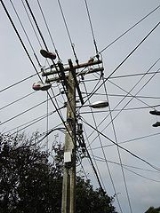
Overhead cable
Encyclopedia

Utility pole
A utility pole is a pole used to support overhead power lines and various other public utilities, such as cable, fibre optic cable, and related equipment such as transformers and street lights. It can be referred to as a telephone pole, power pole, hydro pole, telegraph pole, or telegraph post,...
s. Overhead telephone and cable TV lines are common in North America. Elsewhere, overhead cables are laid mainly for telephone connections of remote buildings and temporary mechanisms, as for example building sites. The same poles sometimes carry overhead powerline
Overhead powerline
An overhead power line is an electric power transmission line suspended by towers or utility poles. Since most of the insulation is provided by air, overhead power lines are generally the lowest-cost method of transmission for large quantities of electric energy...
s for the supply of electric power. Power supply companies may also use them for an in-house communication network
Power line communication
Power line communication or power line carrier , also known as power line digital subscriber line , mains communication, power line telecom , power line networking , or broadband over power lines are systems for carrying data on a conductor also used for electric power transmission.A wide range...
. Sometimes these cables are integrated in the ground or power conductor. Otherwise an additional line is strung on the masts.
Cables are arranged on poles with the most dangerous cables, that is, those carrying power
Electricity distribution
File:Electricity grid simple- North America.svg|thumb|380px|right|Simplified diagram of AC electricity distribution from generation stations to consumers...
, strung highest. Overhead cable systems also include a number of different components for managing signal cables. These include splicing systems that allow multi-conductor cables for distributing telephone signals and snowshoe-shaped devices for reversing the direction of cables.
When metal-based telephone wires are strung on the same utility pole
Utility pole
A utility pole is a pole used to support overhead power lines and various other public utilities, such as cable, fibre optic cable, and related equipment such as transformers and street lights. It can be referred to as a telephone pole, power pole, hydro pole, telegraph pole, or telegraph post,...
s as the power lines, they can pick up noise from the power line. Modern fiber optic telephone cable has the advantage that it can be strung next to power lines without interference.

